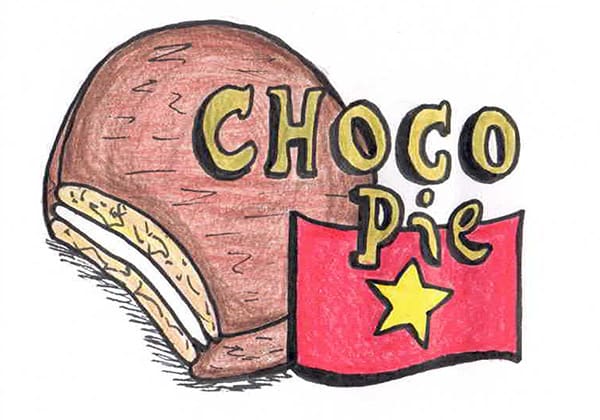A few weeks ago, I walked into a Miracle Supermarket for some late night snacks. I wandered around the aisles looking for familiar treats such as coconut jelly (rau câu dừa in Vietnamese) or mung bean-coated sticky rice (xôi vò). But I was instantly sold when I stumbled upon a nostalgic, red and yellow tin of Choco Pies.
The sumptuous treat — a crumbly cake with a crispy chocolate covering and a creamy marshmallow core, is an iconic staple in Korea and Southeast Asia, which of course includes my homeland, Vietnam. Seeing it on the shelf cued primary school memories; finishing class, holding a copy of either Doraemon or Black Jack, and visiting the local sweets kiosk for a Choco Pie.
The story behind this hugely popular confection is no heroic, rags-to-riches fairytale. Like many other household snacks, Choco Pie was owned and created by Orion Confectionery, one of South Korea’s largest food companies. Founded in 1956, Orion went on to dominate the South Korean confectionery scene alongside other conglomerates Lotte and Crown. However, it was not until 1974 that the firm created its piece de resistance that was the Choco Pie. The cake was inspired by its British and American contemporaries, the Wagon Wheel and Moon Pies. But unlike its rivals, Orion aggressively expanded Choco Pie distribution across China and Southeast Asia by building factories in China, Vietnam, and Russia.
In addition, Orion deployed a range of branding strategies specifically catered for different markets. For instance, in China, the company avoided the romanised ‘Chocopie,’ instead calling it Hao Li You Pai ( 好丽友派) meaning ‘a good friend,’ and inserted Ren (仁) which denotes altruism and virtuousness in Confucian philosophy to appeal to the country’s strong underpinning of family life. In Russia, the pie’s nutritional profile was adjusted to cater for breakfast, seeing that locals preferred Choco Pies with tea. For Orion, despite its direct inspiration from Georgia’s Wagon Wheels, it resonated with public demands for an alternative to American imports — as Orion’s revival coincided with the emergence of Chaebol capitalism.
Choco Pie’s fame is perhaps best encapsulated in its appeal in the most personal of settings – the home. As of 2018, Vietnam consumes the most Choco Pies out of any country – exceeding even its home, South Korea itself — despite having only been introduced to the country in 2005. The treat is so ubiquitous and popular that it is sometimes used as an offering on ancestral altars alongside traditional assortments of fruits and phở. Of course, it is hard to escape the irony — delicious South Korean capitalism juxtaposed against the humility of Confucian ancestor worship.
The story of Choco Pie represents a curious intersection between nostalgia, familial spirituality, and capitalist iconoclasm. Although these may seem irreconcilable, such dissonance may represent an opportune alignment between the self-sacrificial impetus underpinning ancestral worship, commercial novelty and Southeast Asia’s rapid economic transformation. In a way, that sweet and beloved tin of Choco Pie on the altar is a quasi-spiritual celebration of trendy capitalist innovation.





